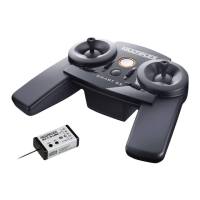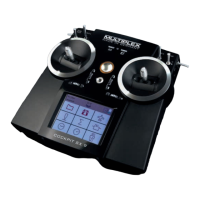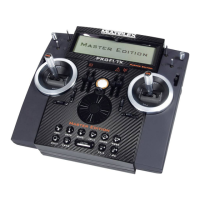ROYAL SX
50
! Note regarding “allocation”
Allocating in this way saves you the bother of holding
the stick at one end-point, and enables you to use
both hands in order to measure the control surface
deflection on the model. If necessary you can make
corrections using the 3-D digi-adjuster.
Calibrating multiple servos with the same function
Example:
Servos 1, 2 and 4 are assigned as HEAD xxx (mixed
function). In the Calibration menu for servo 1, point P3
is opened. If you now press button F to allocate Cen-
tre, all the swashplate servos will immediately move
to centre. At this point you can use the 3-D digi-
adjuster to adjust the current servo to match the other
two.
e. Now use one of the two 3-D digi-adjusters to set
the servo to the desired centre. Any changes you
make are immediately visible on the model itself.
f. When the centre is correct, press the 3-D digi-
adjuster or the ENTER button to confirm the set-
ting, quit the menu via Exit, and select the next
servo you wish to adjust.
This is the procedure for setting maximum servo
travel (control surface deflection):
! At this point set the maximum required value for
blade deflection; this is generally the auto-rotation
value. The smaller values needed for normal flying
can be set for the individual flight phases in the menu
¢Control under Collect..
a. Open the main menu ¤Servo
(press button K).
b. Open the menu Calibration (Calibrate), and
select the servo.
c. Select line P1 and open Parameter:
¤Calibr.HEAD f/b
¨Exit
á
0
P1
-100
%
P2 ---
P3 0%
P4 ---
P5 100%
d. Allocating “maximum” using the F button:
This passes the maximum signal to all the swash-
plate servos so you can set the maximum servo
travel for the selected servo regardless of the posi-
tion of the transmitter control or trim.
Important: moving the stick, or pressing button
F again, erases the allocation!
! Note: maximum servo travel = ±110%
If necessary, servo travel can be increased to 110% on
both sides of centre.
e. Conclude the calibration for P1
(press the 3-D digi-adjuster or the ENTER button).
f. Repeat the procedure for point P5, starting with
Step c.
g. Quit the menu via ¨Exit and set up the other
servos accordingly.
13.6. Checking / adjusting the tail rotor
13.6.1. Checking / changing the direction of rota-
tion of the tail rotor servo
Before you adjust Centre and Travel it is important to
check the direction of rotation of the servo, and re-
verse it if necessary.
TIP: when entering the basic settings connect the
tail rotor servo directly to the receiver output socket for
TAIL (servo 3, if you have not changed the default as-
signment). This ensures that the gyro has no effect on
your settings.
Checking:
Set the tail rotor blades vertical relative to the tail ro-
tor. Move the yaw stick to the left, and observe the re-
sponse of the tail rotor.
13.6.1.1.: Direction of movement of the tail rotor blades
when a “left yaw” command is given
Watch the tail rotor blade whose rounded side is facing
forward: the trailing edge of this rotor blade must
move left when you apply a “left yaw” command. This
would push the tail to the right, causing the helicopter’s
nose to turn to the left.
13.6.2. The TAIL mixer
The ROYAL SX’s TAIL mixer conceals the function
“static tail rotor compensation”, which is also some-
times known as REVO-MIX (revolution mixer). The
TAIL mixer always appears automatically in the main
menu Mixer when you set up a model based on the
model templates HELImech or HELIccpm.
When a helicopter makes the transition from the hover
into a climb or descent, the torque which the tail rotor
has to compensate becomes larger or smaller, with
the result that the helicopter yaws in one direction.
Once set up correctly, the TAIL mixer compensates
for these torque fluctuations, and prevents the model
yawing. It also eases the task of the gyro system, so
that you can set higher gyro gain and thereby obtain
very good tail rotor stabilisation. Four parameters are
required for this:

